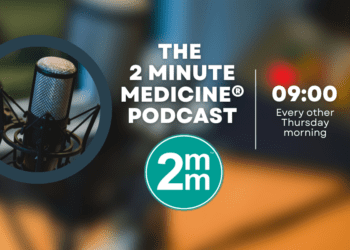#VisualAbstract: Novel malaria vaccine candidate (R21/MM) is safe and highly protective against malaria transmission in African children
1. Vaccine efficacy at 6 months for R21/MM was 74% in group 1 and 77% in group 2.
2. R21/MM showed high malaria-specific antibody titers at 28 days after the third vaccination, which doubled with higher adjuvant doses.
Evidence Rating Level: 1 (Excellent)
Study Rundown: The development of an effective vaccine against Plasmodium falciparum – the major driver of malaria – has remained elusive for many years with previous candidates (RTS,S/AS01) showing suboptimal efficacy. There remains an urgent need to develop improved vaccine candidates against clinical malaria. This randomized controlled trial aimed to assess the safety and clinical efficacy of a new protein-based vaccine, R21, with two different doses of adjuvant Matrix-M (MM), among children aged 5-17 months in Burkina Faso. The primary outcome assessed protective efficacy of R21/MM against malaria from 14 days after the third vaccination to 6 months, while the secondary outcome assessed said efficacy at 12 months. According to study results, R21/MM had a favorable safety profile and was well tolerated, with participants showing high malaria-specific antibody titers at four weeks after the third vaccination. Both doses of MM were highly immunogenic with higher vaccine efficacy than what has previously been reported for RTS,S/AS01. However, this study did not screen for underlying comorbidities in children at baseline, predisposing some to be at greater risk of vaccine-induced adverse events compared to others. Nonetheless, it provides valuable insight into the efficacy of a novel pre-erythrocytic candidate malaria vaccine in children living in Burkina Faso.
Click to read the study in The Lancet
Relevant Reading: Seven-Year Efficacy of RTS,S/AS01 Malaria Vaccine among Young African Children
In-depth [randomized controlled trial]: From May 7 to June 13, 2019, 498 children (aged 5-17 months) were assessed for eligibility at the Institut de Recherche en Sciences de la Santé, Nanoro, Burkina Faso. Eligible participants were separated into three groups (1:1:1): group 1 received 5 μg R21/25 μg Matrix-M (MM), group 2 received 5 μg R21/50 μg MM, and group 3, the control group, received rabies vaccinations. Baseline demographic characteristics were similar across the groups. Altogether, 450 participants (150 per group) were included in the intention-to-treat (ITT) analysis.
The mean age of participants was 11.6 months (standard deviation [SD] 3.8), with an equal proportion of males to females. Eight of 450 participants withdrew from the study prior to the third vaccination (n=442). The primary outcome of clinical malaria was observed in 186 participants at the 6-month analysis (29% in group 1, 26% in group 2, and 71% in group 3). Clinical diagnosis for malaria was made if the child had an axillary temperature ³ 37.5oC and P falciparum density ³ 5000 parasites per μL. Compared to group 3 (the control group), efficacy of R21/MM was 74% (95% confidence interval [CI] 63-82, p<0.0001) in group 1 and 77% in group 2 (95% CI 67-84, p<0.0001). The secondary outcome of vaccine efficacy at 12 months were similar, with 71% efficacy (95% CI 59-79, p<0.0001) for group 1 and 77% efficacy (95% CI 67-84, p<0.0001) for group 2. Participants vaccinated with R21/MM showed high titers of malaria-specific anti-Asn-Ala-Asn-Pro (NANP) antibodies 28 days after the third vaccination, which were doubled with higher adjuvant dose. R21/MM also had a favorable safety profile with no serious vaccine-related adverse events. Findings from this study suggest that R21/MM appears to be safe and immunogenic against malaria, with a high-level of efficacy in African children.
©2021 2 Minute Medicine, Inc. All rights reserved. No works may be reproduced without expressed written consent from 2 Minute Medicine, Inc. Inquire about licensing here. No article should be construed as medical advice and is not intended as such by the authors or by 2 Minute Medicine, Inc.






